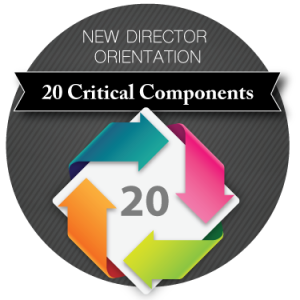Nonprofit marketing can be challenging at best. If you’re like most agencies, you’re constantly on the look out for new ways to share your mission, more effective ways to build awareness, and new cost-effective avenues to get more people to help your cause.
While there are a multitude of channels you can use to market and advertise your organization, I want to share with you something you may not have tried yet — getting your board involved. Many nonprofits look to their board for leadership, but they haven’t yet seen their directors as an extended marketing arm.
Your board of directors is a key group of individuals that know a lot about your organization, have a solid stake in it’s future success, and likely already have a passion for the mission and purpose you serve. Who better to help spread the word? Who better to help build your audience and engage others?
So where do you start? How do you involve your board of directors in nonprofit marketing?
15 Innovative Ways To Get Your Board to Help With Marketing
1. Use their skills in social media to enhance the agency’s visibility, outreach, and community presence. Invite your board members to actively share information about your organization on their own social media networks. Create events such as volunteer days, agency tours, etc. and ask your board members to invite those in their online networks. Share content — including articles, pictures, and updates — about your agency online. Ask your directors to occasionally share these items with their friends.
2. Ask each director personally, to serve as an advocate, or ambassador, in their church or other community service organizations. Each member may have a chance to share your mission with a larger audience.
3. Ask them to consider introducing the Executive Director of the nonprofit to influential friends or business owners. Don’t always think just in terms of fundraising, but in sharing the message, or potentially recruiting volunteers, or other potential board members.
4. Suggest that your board members volunteer at fund-raising or friend-raising events. Your board of directors can do much more then just help plan or attend an event. Give them a specific role at your next event. They could reach out to attendees or introduce attendees to each other. . While this may not be the right role for every board member, you may have a few that would enjoy being more involved.
5. Invite each board member individually, to join the Executive Director or staff on donor thank-you visits. As they get to know more donors and become comfortable in the process, they will feel better about branching out on their own to talk with potential donors.
6. Have them sign thank-you cards or place thank-you phone calls to donors. The more you can involve your board in fundraising-related tasks — especially with donors — the better the potential for success. A one-on-one connection between a donor and board member can reinforce the passion both individuals have for your organization. Nonprofit marketing isn’t just about getting the word out to new people, but also about continuing to strengthen existing relationships.

7. Suggest that they host in-home or social club gatherings with friends to discuss his/her commitment to the agency’s work, the results that are being accomplished, and encourage others to get involved. Keep in mind, many board members could be nervous to do this at first, because they believe they will be required to solicit donations from their friends. Clarify that while donations are always welcome, the primary purpose of these events is to share the mission of the agency.
8. Ask them to sponsor friends, business associates, and other connections at agency events like golf outings, galas, holiday parties, etc. The more people that learn about your nonprofit — especially through your board — the bigger impact you will have. You will also gain more ideal potential volunteers, board members, and donors.
9. Request that each board director write a brief personal testimony for your website. Ask them to describe why they are committed to the agency and helping accomplish its mission. Have them share a client story or specific result that impacted them. What inspires each of your board members will likely inspire others. These stories can be a powerful to share your mission and purpose and build awareness of your organization.
10. Ask if they can provide or find, meaningful and unique auction items for an event — such as someone’s vacation home, interesting trips, or the special experiences — to bolster the agency’s fundraising activities efforts. You may be able to identify items that your attendees would really enjoy, and potentially couldn’t find elsewhere. This will help create buzz around your auction and/or event and help raise awareness and donations.
11. Find out if any of your directors can initiate Cause Marketing and Corporate Partnership opportunities. Depending on the business they work for, there may be opportunities for joint efforts with nonprofit marketing and/or building awareness. Perhaps their company could sponsor a volunteer day, mention your organization at a large corporate event, or even become a corporate donor.

12. Invite them to lead or participate in a Major Gifts or Planned Giving campaign. Involving your board on this level can give a deeper sense of meaning and purpose. They will see first-hand what goes into making these initiatives successful. They will have an opportunity to build relationships with marketing and development staff as well as donors.
13. Suggest that they invite friends and colleagues to tour the agency’s facilities. Or. invite them on a trip to see the agency’s work first hand. Experiencing your organization — and especially the results — will go a long way towards getting someone new involved. Telling someone what you’re doing is good, but showing them will always leave a much more lasting impression. At the end of the visit, ask the individual for their input and feedback. Find out if there is a way to get them involved — perhaps as a volunteer at an upcoming event. This will enhance their experience and get them involved quickly. Many donors and strong supporters begin their relationship with an agency as a volunteer.
14. Identify a few key board members to host Success Celebrations. Using their home or social club, plan a small gathering of staff, volunteers, and friends, to celebrate a recent accomplishment of the organization. Perhaps it’s a milestone you’ve hit in terms of donations, or the launch of a new initiative or service. Clarify that the primary purpose is to congratulate your team on their efforts, and not specifically to acquire donations. Not only will this type of event inspire your team members, but seeing the impact you’re making, and the results being achieved, will inspire others to get involved. Your board members will prefer inviting new people to the event when they know the goal is to share success, rather than solicit donations.
15. At your next board meeting, take a few moments and ask for new ideas. Ahead of your next meeting, send an email out to your board and tell them you will be discussing possible new ways to build awareness. Have them come up with their own ideas and bring these to your next meeting. Discuss them as a group and get feedback from others. If your team selects one or two of these ideas, specifically ask a few board members to get involved in delivering/executing that idea. If you involve your board in the creation and delivery of a new initiative they will work harder to make sure it’s a success.

While donations and fundraising may be the life-blood of your organization, building awareness is critical for creating the relationships you need to make this happen. Your board of directors may be some of the most passionate individuals in your agency. This energy and support for the mission can have a strong impact on others. The more you get your board involved in building your audience, the better chance you have of getting new people to support your efforts.
Struggling to get your board more involved in your organization?
Download this free resource to learn how to get your board members more engaged.


